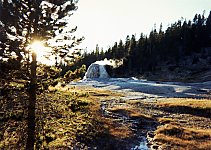 Lone
Star Geyser, Lone Star Geyser Basin. The Lone Star basin is Yellowstone's
smallest geyser basin, about 10 geysers, most of them small. Lone
Star isn't erupting in this shot, but the nine foot cone is still impressive.
The cone is made of a mineral called geyserite, or sinter, which is a form
of silica deposited very slowly by the hot water. It does erupt about
every three hours up to 45 feet. Actually it has a series of short
(minor) and long (major) eruptions, and ends it off with a steam phase
about every three hours. Geysers that have a series of eruptions
separated by a relatively long quiet phase are called cyclic geysers.
There is a log book nearby where hikers can record what Lone Star is doing
while they were there - can be helpful to the next hiker. The Lone
Star basin is about five miles upstream from Old Faithful, and about a
2 1/2 mile walk from the road over a wide paved trail.
Lone
Star Geyser, Lone Star Geyser Basin. The Lone Star basin is Yellowstone's
smallest geyser basin, about 10 geysers, most of them small. Lone
Star isn't erupting in this shot, but the nine foot cone is still impressive.
The cone is made of a mineral called geyserite, or sinter, which is a form
of silica deposited very slowly by the hot water. It does erupt about
every three hours up to 45 feet. Actually it has a series of short
(minor) and long (major) eruptions, and ends it off with a steam phase
about every three hours. Geysers that have a series of eruptions
separated by a relatively long quiet phase are called cyclic geysers.
There is a log book nearby where hikers can record what Lone Star is doing
while they were there - can be helpful to the next hiker. The Lone
Star basin is about five miles upstream from Old Faithful, and about a
2 1/2 mile walk from the road over a wide paved trail.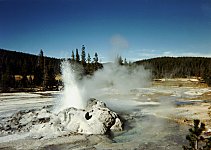 Minuteman
Geyser, Shoshone Geyser Basin. Shoshone is one of Yellowstone's major
geyser basins, but can only be reached by walking 8 1/2 miles one way.
Because of this, there are no crowds at Shoshone. You can get a taste
of what Yellowstone might have been like in the early days. I was
the only person there during this visit of about three hours. There
are also no boardwalks, so be very careful if you visit. Hot springs
can have thin shelves of sinter along their edges that can break way if
you stand on them, and plunge you into boiling water. Minuteman is
another very active cyclic geyser, erupting to 40 feet high.
Minuteman
Geyser, Shoshone Geyser Basin. Shoshone is one of Yellowstone's major
geyser basins, but can only be reached by walking 8 1/2 miles one way.
Because of this, there are no crowds at Shoshone. You can get a taste
of what Yellowstone might have been like in the early days. I was
the only person there during this visit of about three hours. There
are also no boardwalks, so be very careful if you visit. Hot springs
can have thin shelves of sinter along their edges that can break way if
you stand on them, and plunge you into boiling water. Minuteman is
another very active cyclic geyser, erupting to 40 feet high.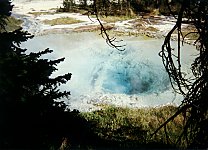 A
hot Spring at Shoshone Basin, possibly Coral Pool. Notice the sinter
covered tree in the pool. The blue color indicates a lack of hot
spring algae, which means the water is very hot, probably over 167F.
A
hot Spring at Shoshone Basin, possibly Coral Pool. Notice the sinter
covered tree in the pool. The blue color indicates a lack of hot
spring algae, which means the water is very hot, probably over 167F.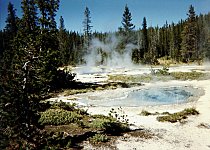 More
hot springs at Shoshone. I believe that the farther one is Boiling
Cauldron.
More
hot springs at Shoshone. I believe that the farther one is Boiling
Cauldron.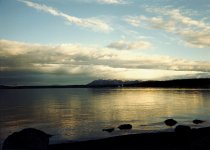 Lake
Yellowstone at sunset. Those are the Red Mountains in the background.
If you look closely you can see steam rising from the West Thumb Basin
on the shore across the bay.
Lake
Yellowstone at sunset. Those are the Red Mountains in the background.
If you look closely you can see steam rising from the West Thumb Basin
on the shore across the bay.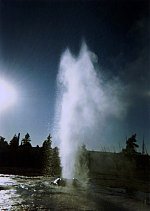 Pink
Cone Geyser, Lower Geyser Basin, along the Firehole Lake Drive. Although
you can't tell from this picture, the sinter cone, and the sinter
deposited by several nearby springs, is pink because of manganese
oxide in the sinter.
Pink
Cone Geyser, Lower Geyser Basin, along the Firehole Lake Drive. Although
you can't tell from this picture, the sinter cone, and the sinter
deposited by several nearby springs, is pink because of manganese
oxide in the sinter.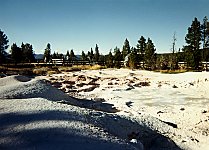 Fountain
Paint Pot, Lower Geyser Basin. Fountain Paint Pot is an example of
a mud pot. Only colorful ones get to be paint pots. In a mud
pot steam rises through a basin of mud. Usually there is no excess
water to run off, and the water is ground water, maybe a bit of condensed
steam. Because of this the thickness of the mud changes along with
seasonal changes in the water table. When the mud is thick (usually
late summer and fall) it is fun to watch the steam bubbles break in the
mud sort of slow motion and spatter the mud around. Fountain Paint
Pot is a must see area. There are an amazing variety of thermal features
in a small area, a very easy boardwalk through them, and an informative
guide available at the start of the trail. It is always nice to know
what you are looking at. You can even return the guide after you
use it if you don't have the fifty cents that it costs.
Fountain
Paint Pot, Lower Geyser Basin. Fountain Paint Pot is an example of
a mud pot. Only colorful ones get to be paint pots. In a mud
pot steam rises through a basin of mud. Usually there is no excess
water to run off, and the water is ground water, maybe a bit of condensed
steam. Because of this the thickness of the mud changes along with
seasonal changes in the water table. When the mud is thick (usually
late summer and fall) it is fun to watch the steam bubbles break in the
mud sort of slow motion and spatter the mud around. Fountain Paint
Pot is a must see area. There are an amazing variety of thermal features
in a small area, a very easy boardwalk through them, and an informative
guide available at the start of the trail. It is always nice to know
what you are looking at. You can even return the guide after you
use it if you don't have the fifty cents that it costs.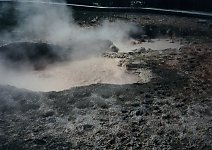 Red
Spouter, Lower Geyser Basin, Fountain Paint Pot Trail. When the ground
is dry Red Spouter is a steam vent. When it is very wet, as in this
picture, it is a reddish, runny mud pot. Sometimes when the water
level is in between Red Spouter throws reddish water into the air.
Red
Spouter, Lower Geyser Basin, Fountain Paint Pot Trail. When the ground
is dry Red Spouter is a steam vent. When it is very wet, as in this
picture, it is a reddish, runny mud pot. Sometimes when the water
level is in between Red Spouter throws reddish water into the air.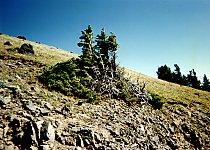 Trees
along the Mt. Washburn Trail. Trees near the timberline can get sculpted
into unusual shapes by the harsh conditions. When all the living
branches grow on one side like this they are called banner trees.
The Mt. Washburn trail is a good day hike. It is a bit of a climb,
but the trail is fairly easy and wide (it used to be a road). There
is, at least when I was there there there was, a pay telephone at the weather
station, fire lookout, whatever it is, at the top. You can call your
relatives back home and make them guess where you are.
Trees
along the Mt. Washburn Trail. Trees near the timberline can get sculpted
into unusual shapes by the harsh conditions. When all the living
branches grow on one side like this they are called banner trees.
The Mt. Washburn trail is a good day hike. It is a bit of a climb,
but the trail is fairly easy and wide (it used to be a road). There
is, at least when I was there there there was, a pay telephone at the weather
station, fire lookout, whatever it is, at the top. You can call your
relatives back home and make them guess where you are. A
view along the Mt. Washburn trail. You can see the Grand Canyon of
the Yellowstone and some steam columns rising from a few thermal areas.
A
view along the Mt. Washburn trail. You can see the Grand Canyon of
the Yellowstone and some steam columns rising from a few thermal areas.back to the Yellowstone Pictures Page